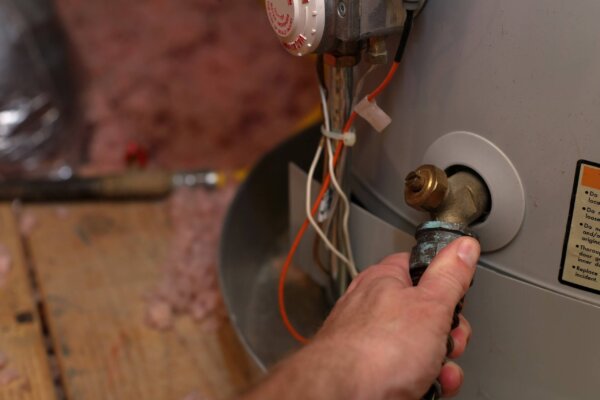Can Broken Water Heaters Create Carbon Monoxide Issues?
Many of us take water heaters for granted. We rely on them every day without thinking too much about how they work and what they may need from us. We’re all fortunate in this regard. However, all water heaters have the potential to experience issues. Of course, it’s never fun to go without hot water. Broken water heaters can also cause much more significant issues. In some cases, they may create carbon monoxide, which is poisonous to humans and animals.
Gas-Powered Water Heaters
Only certain types of water heaters can potentially cause carbon monoxide. If you have an electric water heater, you won’t have to worry about this issue at all. Only water heaters that are powered by natural gas or oil are at risk. The risk can be very low if everything is functioning properly. Since problems can arise unexpectedly, it’s a good idea to stay informed. Keep reading to find out more about the signs of a carbon monoxide leak and what to do about it.
What Exactly Is Carbon Monoxide?
Before going on any further, let’s go over what carbon monoxide is. It’s a type of gas that you cannot see or smell. Its invisibility adds to its danger, as people often don’t realize that there’s a problem until it’s too late. When you breathe it in, it starts to replace the oxygen in your blood. This can make you feel tired and have shortness of breath. You may feel nauseous or start to vomit, your head may hurt, and you may feel dizzy or lightheaded. In addition, you may notice that your heart is beating much faster than usual. Unfortunately, carbon monoxide can cause you to lose unconsciousness, and in severe situations, it can cause death.
Carbon monoxide is created when a fuel is burned without enough oxygen being present. Rather than the fuel combusting completely and creating heat, with carbon dioxide and water as byproducts, there is incomplete combustion. The fuel, which contains carbon and hydrogen, isn’t completely oxidized, and as a result, carbon monoxide is formed.
A water heater that hasn’t been installed or maintained properly may be able to create carbon monoxide. In addition, a water heater that has been damaged in a certain way may be able to cause this problem.
Signs of a Carbon Monoxide Leak
The signs of a carbon monoxide leak might not be obvious at first. If you have any flu-like symptoms or feel nauseous or fatigued without explanation, there may be a leak. If multiple people in the same household develop these symptoms around the same time, an environmental cause could be more likely.
While carbon monoxide doesn’t have any smell on its own, the process of incomplete combustion can sometimes lead to the development of aldehydes. Aldehydes do smell, and they can be pretty pungent. Any unusual odor near your water heater should cause concern.
One other thing that some people have noticed when carbon monoxide is present is a difference in their burner flames. If there isn’t enough oxygen, the flame may have a yellow tinge to it. It may seem bigger than usual, though it may not be uniform in size. Please note that visual inspection isn’t enough of a diagnostic tool. Rather, it’s just one piece of the puzzle.
Steps to Take
If you think that carbon monoxide is in your home, you’ll need to move quickly to keep everyone safe. If it seems safe to do so, turn off the gas to the water heater. Have everyone get outside the home and open a few windows as you leave—if you can. Call 911 to request formal assistance. In some cases, you may have to receive medical treatment. A professional team will come out to your place and assess the situation. If the water heater is the culprit, it will need to be closely inspected to figure out what happened. Repairs may be able to fix some situations, and some circumstances will require the replacement of a water heater. We know that this requires a big investment, but remember that your safety is the most important thing.
Preventing Future Problems
Getting a carbon monoxide detector is one of the most important things you can do to keep yourself safe from this poisonous gas. Since you can’t see it or smell it, you might not know there’s a problem until it’s too late. If you have a carbon monoxide detector, though, you will know when there’s an issue. This detector will alert you to the presence of carbon monoxide at certain levels. If there is very little carbon monoxide in the air, it may take several hours before the alarm goes off. If carbon monoxide levels are dangerously high, then the alarm can notify you quickly, potentially within a few minutes. It’s recommended that you have a carbon monoxide detector on every floor of your home, including a basement if you have one. You can even place several detectors on the same floor. This could be a good idea for a floor with several bedrooms because it may be hard to hear an alarm in the middle of the night if it’s too far from where people are sleeping.
Another way to be proactive is to make sure you have your water heater professionally inspected and maintained. Regular maintenance, which could be an annual occurrence, can ensure that your system can heat your water effectively. It can also make sure that the system is safe to use and that no carbon monoxide will be created. If any components have gotten damaged, this will be revealed during a maintenance appointment. It gives you a perfect opportunity to address an issue before it becomes a significant concern.
If you are planning on getting a new water heater at some point, you’ll need to have a reputable company take care of the installation for you. Improper installation can lead to problems with airflow, which can lead to the development of carbon monoxide. Anything that involves a natural gas appliance requires a lot of care, and you definitely don’t want to cut corners when it comes to installation.
Ready to Help
At Crystal Blue Plumbing, Heating & Air, we focus on giving our customers our best effort, and we can help you with your water heater in Sacramento. Our business has been family-owned and -operated for more than four decades. We’ve enjoyed getting to know many people in our community through our work, and we always look forward to meeting new customers. Please feel comfortable asking us any of your questions. We know that many people don’t have that much knowledge about various HVAC or plumbing systems, especially when it comes to the details. We’re here to be a resource that you can count on. Plumbing is one of our specialties, and we’re available to install, repair or maintain water heaters, outdoor sprinklers, bathroom fixtures, water softeners, gas piping and more. We have experience with drains and sewers as well as sump pumps, slab leaks and water purifiers. In addition, we can help you with your air conditioner, heater, thermostat, humidifier or dehumidifier, and air filtration or air purification system. Contact Crystal Blue Plumbing, Heating & Air for more information!








